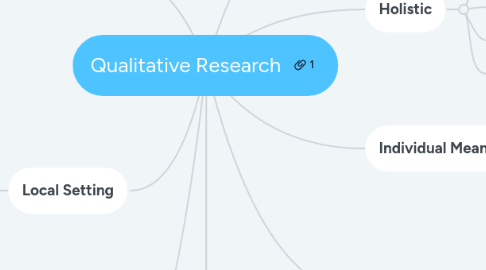Qualitative Research
da Art Fuller


1. Local Setting
1.1. Observation Protocols
1.2. Site Selection
1.3. Participant Selection
1.4. Recruitment Strategies
1.5. Interview Protocols
2. Flexible & Multiple Sources
2.1. Observations
2.2. Field Notes & Guides
2.3. Interviews
2.4. Documents
2.5. Audio Visuals
3. Reflective
3.1. Data Collection
3.2. Data Software Tools
3.3. Data Review
3.4. Data Analysis
3.5. Narrowing the Data
3.6. Interpreting the Intended Meaning
3.7. How does the researchers background influence interpretation of the meaning?
4. Individual Meaning
4.1. Complex Descriptions
4.2. Different Perspectives
4.3. Value of Each Voice
5. Credible
5.1. Credibility
5.1.1. Triangulation
5.1.2. Member Checking
5.1.3. Negative Case Analysis
5.2. Transferability
5.2.1. Thick description
5.2.2. Purposive Sampling
5.3. Dependability
5.3.1. Audit Trail
5.3.2. Traingulation
5.4. Confirmability
5.4.1. Audit Trail
5.4.2. Triangulation
5.4.3. Reflexivity
6. Holistic
6.1. How do the participants derive meaning?
6.2. Coding / Themes
6.2.1. Specificity of the Description / Code
6.3. Peer Coding & Confirmation
6.4. Identifying Bias
7. Researcher as the Research Instrument
7.1. Defining the procedures
7.1.1. Setting The schedule
7.1.2. Recruiting participants
7.1.3. Following up with participants
